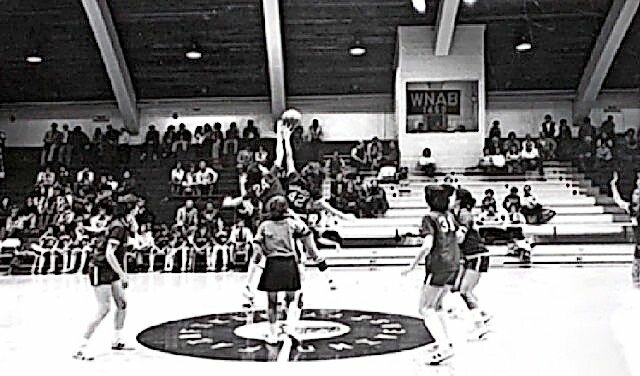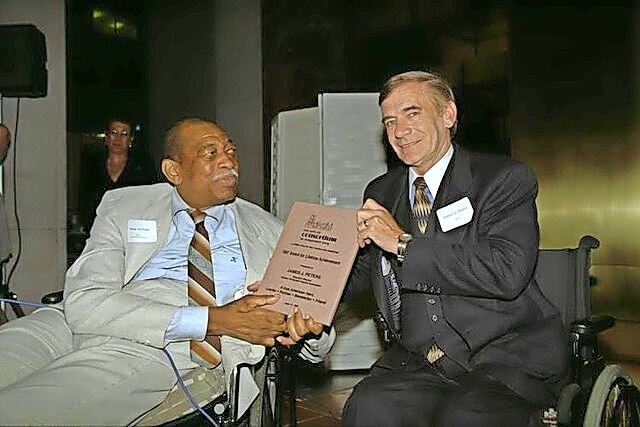Manhattan College athletics has rich, century-old history here
Brother Jasper predated Bronx move, but his namesake has conquered
Manhattan College got their curtain call at Yankee Stadium last Friday to mark the school’s 100-year history in the Bronx. The Riverdale Press takes a look at the wins and characters which have contributed to the Jaspers athletics history since its relocation to Riverdale from Manhattan in 1923.
Dim the lights and open the curtains on an eclectic record of winning for the Jaspers since their name became a misnomer with the move to the Bronx from the old campus at 132nd Street and Broadway.
In a city steeped in basketball history, Manhattan men’s basketball has been the most popular attraction on campus. They have won three NCAA Tournament games across eight appearances.
The most recent win came in 2004 when the 12-seeded Jaspers defeated the 5-seeded Florida Gators, 75-60, on the strength of 26 points from star player Luis Flores in the opening round game. The other two wins were as a 13-seed over 4-seeded Oklahoma Sooners in the opening round of the 1995 tournament, and an 89-84 stunner against the 26-1 Jerry West-led West Virginia Mountaineers at Madison Square Garden in 1958.
Manhattan’s baseball program may predate the New York Yankees, but they never had a bigger win than the 4-1 triumph over the sixth-ranked Nebraska Cornhuskers in the opener of the Lincoln Regional during the 2006 NCAA Tournament. It had been since 1957 — a 2-1 loss to Penn State — that the baseball team qualified for the tournament, and beating the Cornhuskers on their own home field was historic. Nebraska featured future MLB pitchers Joba Chamberlain and Tony Watson. For the Jaspers, Chris Cody’s complete-game performance on 142 pitches and home runs from Matt Rizzotti and John Fitzpatrick helped fuel the historic result.
“It was one of the most proud moments of my life and career,” says Cody, owner of the most wins, strikeouts, and complete games in program history. “It’s cool to be able to queue up Youtube every now and again to relive it.”
Manhattan originally fielded a varsity football team before taking hiatus from 1904 to 1924. The return came a year after the re-establishment of the school in the Bronx and the football program used the Polo Grounds in Upper Manhattan and Ebbets Field in Brooklyn, best known for being the home stadiums for the New York Giants and Brooklyn Dodgers, respectively.
The 1932 team is a lasting relic not so much for its record of six wins, three losses, and two ties, but more for playing against the University of Miami in the first ever Festival of Palms, later rebranded to the Orange Bowl. The Jaspers had to travel three days to get to Miami onboard the S.S. Shawnee, which departed from 110th Street. In front of 2,000 fans, Manhattan lost 7-0.
Women’s basketball had four bids in the big dance coming in 1987, 1990, 1996 and 2003. Women’s volleyball, men’s lacrosse, and softball each have made two appearances in the NCAA Tournament.
The most important victory of them all came with the men’s track and field team capturing the 1973 NCAA Championships. With a six-point margin of victory, Manhattan became the smallest Division I school to ever win a national championship.
Lots of characters
The legend of Junius Kellogg would be on the first page of any historical record about Manhattan College Athletics. Kellogg, class of 1953, was the first African American basketball player in the school’s history and helped expose a powerful gambling ring which had taken college basketball in New York City by storm in the 1950s.
“He brought Manhattan College a tremendous sense of honesty and integrity,” said Bruce Wolk, author of a manuscript entitled “Junie and Me” about Kellog’s friendship with teammate Bob Otten. “Despite some of the not so nice attitudes against him.”
Jack Powers, class of 1958, was a 1,000-point scorer for men’s basketball and played on two NCAA Tournament teams. His 29 points helped vault the Jaspers past West Virginia, and Powers later served as basketball coach for 10 years with a separate stint as athletics director. During those years, Manhattan secured Madison Square Garden as a hybrid home court until the construction of Draddy Gymnasium in 1978.
The coach of those exciting basketball teams was Ken Norton, who spent 22 seasons in charge of men’s basketball and later served as athletics director until he retired in 1979. He also coached baseball and golf.
Manhattan sent 11 players to either the NBA or ABA, starting with Dick Murphy in 1947 and most recently, Chris Smith, in 2014.
Manhattan men’s basketball has been home to some big name coaches over the years. Former St. John’s coach Fran Fraschilla and former Villanova coach Steve Lappas each had stints as Manhattan head coach, spanning the late 1980’s with Lappas and into the mid-1990’s with Fraschilla.
Bobby Gonzalez was the program’s caretaker in the early 2000s before moving on to Seton Hall. Steve Masiello, who led the program from 2011 to 2022, is now the associate head coach at St. John’s University. Gordon Chiesa had a run with the Jaspers from 1981 to 1985 and later served for 16 seasons as an assistant for the Utah Jazz under Hall of Fame coach Jerry Sloan.
There are 10 track and field athletes who went on to compete in the Olympics. The 1930s birthed the rise of Frank Crowley, who ran the 10,000-meter race at the 1932 Olympics. The 1940s was dominated by Ed O’Toole, who ran the 10,000 meters in the 1948 Olympics. The 1950s are remembered for four future Olympic athletes in Lindy Remigino, Lou Jones, Ken Bantum, and Tom Murphy.
Remigino was dubbed the “world’s fastest human” for winning gold in the 100-meter dash, as well as bringing home gold in the 4x100 meter relay for Team USA, at the 1952 Olympics. Jones was a one-time world record holder in the 400 meters and had a leg in the 4x400 meter relay won by Team USA in the 1956 Olympics.
Dine Potter and Pat McGrath starred in the 1990s, with Potter running in the 4x100 and 4x400 relays at the 1996 Olympics and McGrath a hammer thrower at the 2000 Olympics.
Aliann Pompey, class of 1999, is known as the first women’s runner from the school to win an NCAA title and also is credited for several school records. She represented Guyana in four Olympics.
Fred Dwyer was the men’s cross country and track and field coach for 24 years starting in 1969. Dwyer teamed with assistant coach Frank Gagliano to help deliver the 1973 national championship. Part of that team were the runners of the distance medley relay, consisting of John Lovett, Joe Savage, Ray Johnson, and Tony Colon. Their efforts in the relay clinched the championship.
“It was a great camaraderie of guys in both the field events and on track,” Lovett said.
Another member of that team, Mike Keogh, was the individual champion in the two-mile race, which counted toward the team total. Keogh made his Olympic debut in the 5000 meters at the 1974 Olympics.
The running history is further bolstered by Joseph Kearney, class of 1967, who set nine school records. The track inside Draddy Gymnasium on campus is named in Kearney’s honor. Matt Centrowitz ran for the Jaspers in 1975 before transferring to University of Oregon. He is the owner of the fourth-best 1500-meter time on the high school level (3:36.7) and was a four-time national champion in the 1500-meter event.
Vincent dePaul Draddy, benefactor of today’s Draddy Gymnasium, was the quarterback and captain of the 1929 football team before becoming a successful businessman. Chick Meehan was the coach of the 1932 football team and is the program’s all-time wins leader with 31 across six seasons.
John “Doc” Johnson was the athletic trainer from 1947 to 2003, while occupying the same role for the Giants until 2008. The athletic training room inside Draddy is named for Johnson.
“He treated all of us (at Manhattan) like we were professional teammates,” said Stiven Misevic, a member of the class of 1991 and the men’s soccer team. “It didn’t matter if we were making millions or nothing.”
Bob Byrnes was the school’s longest-tenured athletics director from 1988 to 2014, in which he oversaw a total of 78 MAAC Championships.
The approval and establishment of Title IX in 1972 set the wheels in motion for the creation of a women’s basketball team three years later. Well before her stint as athletics director, Marianne Reilly, class of 1982, became the first Manhattan basketball player to score 1,000 career points. Two years younger than Reilly was Sheila Tighe, who scored the most points in school history with 2,412 points.









